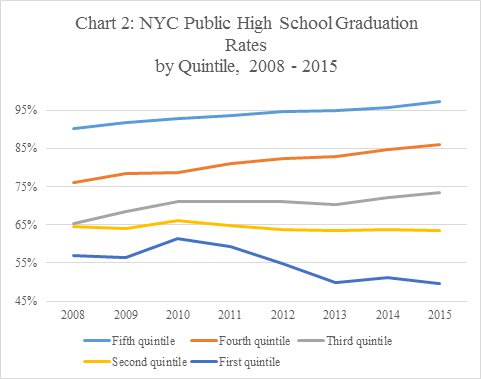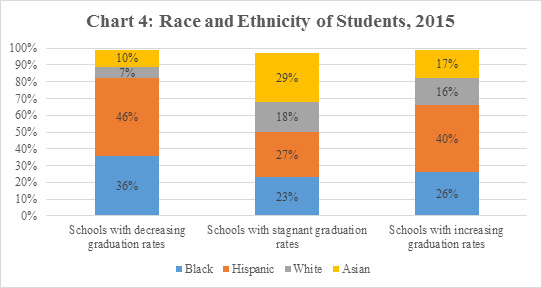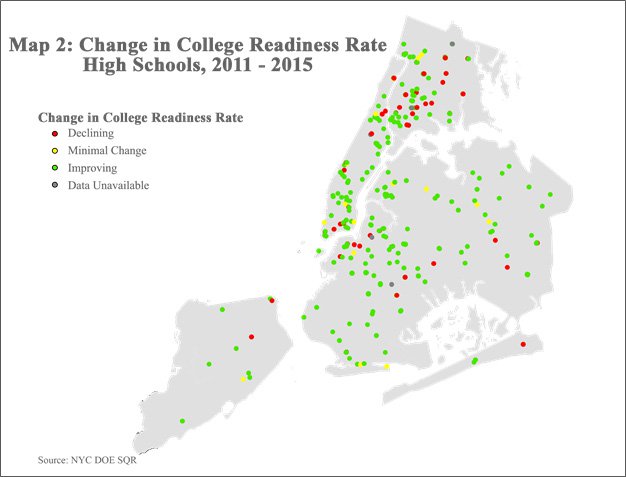Diploma Disparities: High School Graduation Rates in New York City
Introduction
Few milestones in the life of any student are as momentous or time-honored as graduating from high school. And while citywide graduation and college readiness rates have been rising in New York City in recent years, a closer examination of these trends indicates that persistent problems remain in many communities.
Specifically, a new analysis by the Office of Comptroller Scott M. Stringer reveals that the graduation gap in city high schools actually widened in recent years. Over this period, while high schools in the highest performing quintile saw their graduation rates jump from 93 percent to 97 percent, those in the lowest quintile experienced an 11 drop, from 61 percent to 50 percent. In all, graduation rates are actually declining at 110 city high schools, which together educate about one-fifth of New York City public high school students. These schools are most heavily concentrated in school districts in the Bronx, and students at these schools are disproportionately Black and Hispanic. In addition, students at these schools are more likely to be eligible for free lunch, receive public assistance, or live in temporary housing than students that attend high schools with rising graduation rates. The analysis shows that these 110 schools have been on the decline since at least 2010, a downward trend that is largely masked when graduation rates are viewed only from the vantage of the citywide average.
Additionally, despite the fact that a higher percentage of students are graduating citywide, less than half of city high school graduates are determined to be “college ready.” College readiness rates declined at about 16 percent of schools between 2011 and 2015, with the lowest levels of college readiness clustered in school districts in the Bronx and Brooklyn. Persistent racial gaps exist in college readiness levels as well.
This analysis relies on New York City Department of Education data and includes the 334 schools that consistently graduated students each year between 2011 and 2015. A total of 103 high schools were excluded: those that were created after 2011, transfer high schools, and schools in Districts 75 and 79.[1]
Graduation Rates in New York City
Looked at from a citywide perspective, New York City has made consistent progress in recent years in boosting overall graduation rates, as shown in Chart 1. According to data from the New York City Department of Education (NYCDOE), the four-year graduation rate rose from 60.7 percent for the class that entered high school in the fall of 2004, to 70.5 percent for those who entered high school in the fall of 2011.[2] These gains are an important achievement and represent true progress in ensuring that New York City students have the education they need to go to college or find employment.

However, closer examination reveals this growth is driven largely by gains at higher performing schools. Chart 2 displays the 334 schools that graduated students every year between 2011 and 2015. Among these schools, those with the highest graduation rates saw their graduation rates improve by an impressive seven percentage points over the last eight years, growing from 90 percent in 2008 to 97 percent in 2015. Meanwhile, schools in the second highest quintile gained even more ground, with rates increasing a full 10 percentage points (from 76 percent to 86 percent).
At the same time, graduation rates at high schools in the bottom quintile dropped in 2015 to a low of 50 percent, falling a full 11 percentage points from a recent high of 61 percent in 2010, and from 57 percent in 2008.

As shown in Map 1 below, between 2011 and 2015, 110 public high schools had decreasing graduation rates, 166 had increasing graduation rates, and 57 had graduation rates that were relatively stable, changing by only two percent in either direction during this time.

The 110 schools with decreasing graduation rates between 2011 and 2015 served approximately 21 percent of New York City public high school students in 2015. Approximately 42 percent of students attended schools with rising graduation rates in 2015. Twenty percent attend schools whose graduation rates were stagnant during these years. Seventeen percent of high school students attend schools that did not consistently graduate students between 2011 and 2015. This is largely because the schools did not exist during the full timeframe.
Additional Demographic Information
As shown in Chart 3 below, schools with a higher Economic Needs Index also tended to have the lowest graduation rates, while the converse was also true. The Economic Need Index measures the socioeconomic circumstances of a school’s population and assigns a score to each school based on the number of students eligible for free lunch or public assistance or who live in temporary housing. A higher score indicates that more students are eligible for these programs or live in temporary housing.
Students in the lowest quintile of the Economic Need Index had a 51 percent graduation rate, while those in the highest quintile had a 96 percent graduation rate.

Current data also shows that, despite overall improvements, significant disparities in graduation rates exist in New York City when viewed through the lens of race and ethnicity. While 82 percent of white students graduated in four years, only 64 percent of Hispanic students and 65.4 percent of black students did so in 2015.[3] As shown in Chart 4, among the schools included in the analysis, schools with decreasing graduation rates between 2011 and 2015 had a higher share of black and Hispanic students (88 percent combined) than the school population generally (63 percent).

In total, during the last nine years, 33 percent of black students in public high schools in this analysis attended a high school that has experienced an overall decline in graduation rates since 2011. The same is true for only 12 percent of white students.
College Readiness
In addition to graduation rates, school performance may also be measured by how many students are deemed to be “college ready,” defined by the City as a student who does not require remediation in either math or reading before taking a college level course.[4] The citywide college readiness rate lags far behind the graduation rate. Over half of New York City public high school graduates are deemed not ready for college upon graduation by the City’s own definition.[5]
As shown in Map 4, college readiness scores declined at about 16 percent of public high schools for which data was available between 2011 and 2015. Readiness scores increased at 79 percent of schools and were stagnant at 5 percent of schools.

Low college readiness levels are most acute in parts of Brooklyn and the Bronx, while college readiness levels are consistently higher in Staten Island, Manhattan, and Queens.
In sum, 77.8 percent of City University of New York (CUNY) fall 2015 freshmen who were NYCDOE graduates and attended a CUNY community college were assigned to remediation in at least one subject. This number has been fairly consistent since 2002, despite increasing graduation rates.[6]
As with graduation rates, the racial gap in college readiness is significant. According to a report from GraduateNYC, the rates of college and career readiness for Hispanic males and Black and Hispanic females were about 40 percent the rate of their White peers, while the rate for Black males was about 30 percent the rate of their White peers in 2014.[7]
Recommendations
A closer look into graduation and college readiness rates at New York City public high schools reveals deeply uneven outcomes across the City. While a number of high performing schools continue to see graduation and college readiness rates increase, too many schools have seen their graduation and/or college readiness rates fall in recent years.
These problems are fundamentally complex and multifaceted, and this report acknowledges that there is no easy fix. As the City continues to explore strategies for improving outcomes, the policy proposals below are worth consideration.
Expansion of High School to College Bridge Programs
In partnership with the DOE, CUNY runs many bridge programs outlined below with excellent results. The City should consider expanding these programs.
- Accelerated Study in Associate Program (ASAP)
Over the last nine years, Accelerated Study in Associate Program (ASAP) has served over 12,780 students and the cohort size has been increasing in recent years. The program requires students to attend school full-time and provides comprehensive supports and financial services. Participants have small class sizes, a fixed course load, comprehensive advisement, academic and career development services, monthly Metrocards, textbooks, and a waiver of any balance between financial aid and tuition/fees.[8] ASAP’s students graduate at over double the rate (53 percent v. 23 percent) of similar students who are not in the program.[9]
- Lessons in Navigating College Transition (LINC)
Three thousand high school seniors who are on track to graduate but have not met CUNY’s college ready benchmarks are served annually by Lessons in Navigating College Transition (LINC).[10] Of the high school participants who graduate, 70 percent enroll in a postsecondary institution within nine months. They participate in one or more of the following programs: (1) A pre-college transition course to prepare for CUNY Assessment tests, (2) mentorship from a current college student while in high school, and (3) continued mentorship from trained students, provided they complete the pre-college transition course and enroll at a CUNY community college.
- CUNY START
CUNY START enrolls prospective CUNY students who have been accepted to college because they have a high school or high school equivalency diploma but are not ready for college-level work based on their scores on CUNY’s Assessment Tests.[11] Students who participate in CUNY Start delay college matriculation for one semester. Instead, they begin with a semester of noncredit, time-intensive instruction in reading, writing, and mathematics with a prescribed curriculum and instructional approach. The program provides academic advising, tutoring, and a weekly “College Success” seminar. Students pay a 75 dollar fee, which includes the textbooks.[12] There are full time and part time programs.
Expand Early College High Schools
One promising education model proven to boost high school graduation rates, college attendance rates, and the percentage of students obtaining a college degree is the Early College High School. These schools offer students the opportunity to earn college credit or a post-secondary credentials at no or low cost, while also earning a high school diploma.
In 2015, CUNY’s Early College High Schools achieved an 88 percent graduation rate, above the citywide rate of 70.5 percent. A total of 73 percent enrolled in college the fall after graduation. An Early College High School operated by Bard had similar success: More than 94 percent of graduates completed a bachelor’s degree. African American students at Bard are more than twice as likely to complete their BA/BS in four years as statistically matched students at New York City public high schools. Currently, 13 of 32 school districts host a least one early college high school.
Invest in Early Childhood Education
Preschool-aged children achieve 90 percent of their adult brain volume by age six. This physiological growth allows children to develop functional skills related to information processing, comprehension, language, emotional regulation, and motor skills.[13] Evidence demonstrates that early childhood education interventions have positive impacts on high school graduation rates.[14]
A study commissioned in late 2015 found that in New York City, only 14 percent of income-eligible infants and toddlers up to age three receive subsidized early childhood education.[15] There are over 200,000 income eligible children ages 0-5 throughout New York City who are not served by Administration for Children’s Services (ACS).[16] While creating seats for the 137,000 infants and toddlers who are eligible for subsidized early child care but not receiving it will require the State and City, along with the federal government, to increase spending on these programs, doing so could have long-term benefits for high school success.
Acknowledgements
Comptroller Scott M. Stringer thanks Sally Frank, Policy Analyst and the lead writer of this report, and Nicholas Shatan, Policy Intern, who conducted data analysis for this report.
Comptroller Stringer also recognizes the important contributions to this report made by: Zachary Steinberg, Deputy Policy Director; David Saltonstall, Assistant Comptroller for Policy; Traci Oshiro, Nachman Sanowicz, Computer Systems Manager; Nachman Sanowicz, Computer Systems Manager; Antonnette Brumlik, Senior Web Administrator and Archer Hutchinson, Creative Lead and Web Developer.
The cover of this report is a graph of New York City Department of Education data and includes the 334 schools that consistently graduated students each year between 2011 and 2015.
Endnotes
[1] The analysis includes 30 of the 94 Renewal Schools. Their success is mixed: 14 have declining graduation rates, 8 have improving graduation rates and 7 have minimal change.
[2] http://schools.nyc.gov/Accountability/data/GraduationDropoutReports/default.htm
[3] http://www1.nyc.gov/office-of-the-mayor/news/052-16/with-graduation-rates-rising-mayor-de-blasio-congratulates-students-educators#/0
[4] http://www.graduatenyc.org/wp-content/uploads/2016/05/GNYC-Report-Brief-2.pdf The cited Graduate NYC report defines college readiness as “meeting the following minimum requirements for proficiency in order to begin taking college credit-bearing coursework: Reading and Writing: a score of 480 or above on the critical reading section of the SAT, 20 or above on the ACT English test, or 75 or above on the English Regents exam. Mathematics: a score of 500 or above on the math section of the SAT, 21 or above on the ACT Math test, 70 or above on the Regents Algebra I exam or Common Core Algebra exam, or 80 or above on the Regents Integrated Algebra, Geometry, or Algebra II/Trigonometry exam, plus successful completion of an Algebra II or trigonometry course.”
[5] http://www1.nyc.gov/office-of-the-mayor/news/052-16/with-graduation-rates-rising-mayor-de-blasio-congratulates-students-educators#/0
[6] http://www2.cuny.edu/wp-content/uploads/sites/4/2014/12/masterplan.pdf
[7] http://www.graduatenyc.org/wp-content/uploads/2016/05/GNYC-Report-Brief-2.pdf
[8] CUNY Masterplan for 2016 p. 53
[9] CUNY supplied document: “Significant Increases in Associate Degree Completion Rates: CUNY Accelerated Study in Associates Programs 12/14/2015”
[10] CUNY supplied document: “SUD CUNY LINCT to Success Overview”
[11] http://www1.nyc.gov/nyc-resources/service/1475/cuny-start-program
[12] http://www.mdrc.org/publication/building-college-readiness-matriculation
[13] http://www.cdc.gov/policy/hst/hi5/earlychildhoodeducation/index.html
[14] https://www.brookings.edu/research/the-long-term-impact-of-the-head-start-program/
[15] http://www.cccnewyork.org/blog/nyc-gets-an-incomplete-grade-in-early-childhood-education/
[16] http://www.campaignforchildrennyc.com/wp-content/uploads/2015/09/Child-Care-Need-2015_final.pdf